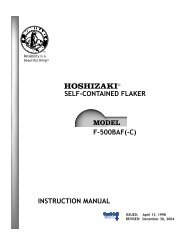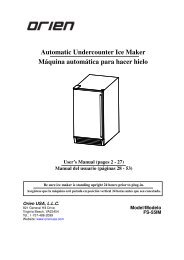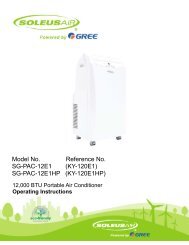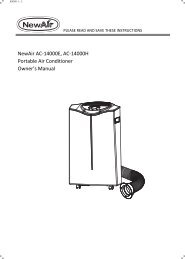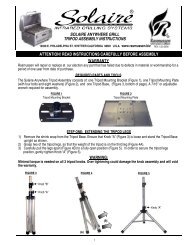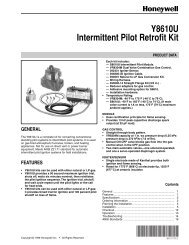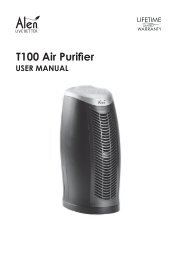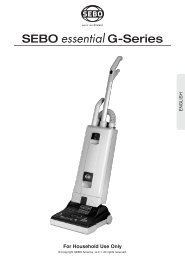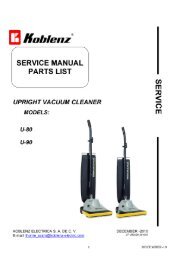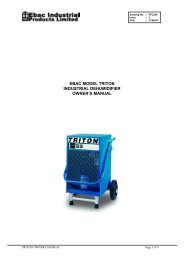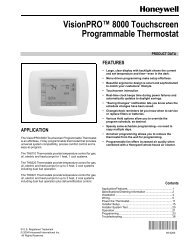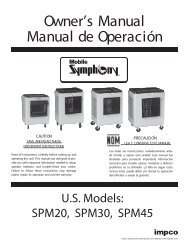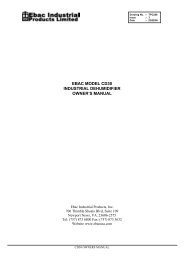™ Care & Use of Your New Grill - Rasmussen
™ Care & Use of Your New Grill - Rasmussen
™ Care & Use of Your New Grill - Rasmussen
You also want an ePaper? Increase the reach of your titles
YUMPU automatically turns print PDFs into web optimized ePapers that Google loves.
<strong>Care</strong> <strong>of</strong> Stainless Steel<br />
Stainless Steel is widely used for catering<br />
and residential kitchen equipment because<br />
<strong>of</strong> its strength, its ability to resist corrosion<br />
and its ease <strong>of</strong> cleaning. In fact, stainless<br />
steel ranks alongside glass and new china<br />
in terms <strong>of</strong> "ease <strong>of</strong> cleaning" and in<br />
percentage removal <strong>of</strong> bacteria during<br />
washing up. As a result <strong>of</strong> these virtues,<br />
the metal is <strong>of</strong>ten taken for granted and<br />
it is assumed that no problems will arise<br />
during its usage. However, some care is<br />
required to ensure that the stainless steel<br />
can live up to this reputation.<br />
DAY TO DAY CARE<br />
To maintain the original appearance <strong>of</strong><br />
your SOLAIRE INFRARED <strong>Grill</strong>, a regular<br />
cleaning routine should be carried out<br />
using the following guidelines:<br />
1. After use, following the safety precautions<br />
detailed on Pgs. 2-3, wipe the<br />
<strong>Grill</strong> with a s<strong>of</strong>t, damp, soapy cloth, or<br />
cleaner such as 409, and rinse with<br />
clean water, preferably warm/hot<br />
water. This should remove most substances<br />
encountered during the grilling<br />
process.<br />
2. For more tenacious deposits, including<br />
oil, grease and water-borne deposits,<br />
use a multi purpose cream cleanser<br />
and apply with a s<strong>of</strong>t damp cloth.<br />
Rinsing with fresh water, as above,<br />
should follow this.<br />
3. For really stubborn dirt or burnt on<br />
grease, a nylon-scouring pad may be<br />
used in conjunction with the cream<br />
cleanser, such as S<strong>of</strong>t Scrub. On no<br />
account should "wire wool" pads be<br />
used unless they are made <strong>of</strong> stainless<br />
steel.<br />
4. Harshabrasives and scouring materials<br />
should not be used for cleaning<br />
stainless steel as they will leave scratch<br />
marks in the surface and damage the<br />
Page 10<br />
appearance <strong>of</strong> the <strong>Grill</strong>. Likewise do<br />
not use wire brushes, scrapers or contaminated<br />
scouring pads.<br />
5. <strong>Your</strong> SOLAIRE INFRARED <strong>Grill</strong> has a<br />
directional polished grain, any cleaning<br />
with abrasives should be carried<br />
out along this grain and not across it.<br />
6. After use, always remove wet cleaning<br />
aids (such as cloths, pads, containers)<br />
from the surface, to avoid formation <strong>of</strong><br />
water marks/stains.<br />
7. If required, dry the <strong>Grill</strong> after use with<br />
a s<strong>of</strong>t dry cloth or towel.<br />
There are many different stainless steel<br />
cleaners available. Always use the mildest<br />
cleaning procedure first, scrubbing<br />
in the direction <strong>of</strong> the grain. To touch up<br />
noticeable scratches in the stainless steel,<br />
sand very lightly with dry 100 grit emery<br />
paper in the direction <strong>of</strong> the grain. Specks<br />
<strong>of</strong> grease can gather on the surfaces <strong>of</strong><br />
the stainless steel and bake on to the<br />
surface and give the appearance <strong>of</strong> rust.<br />
For removal use an abrasive pad (not<br />
steel wool) in conjunction with stainless<br />
steel cleaner.<br />
If the preceding guidelines are adhered<br />
to, your SOLAIRE Stainless Steel <strong>Grill</strong><br />
should <strong>of</strong>fer excellent life and should live<br />
up to its reputation <strong>of</strong> being "stainless".<br />
Neglect <strong>of</strong> this practice, however, can<br />
lead to deterioration <strong>of</strong> the surface and,<br />
in some extreme cases, corrosion <strong>of</strong> the<br />
steel itself. The two most common types<br />
<strong>of</strong> corrosion that may be encountered,<br />
particularly on stainless steel, are rust<br />
marks and pitting <strong>of</strong> the surface.



